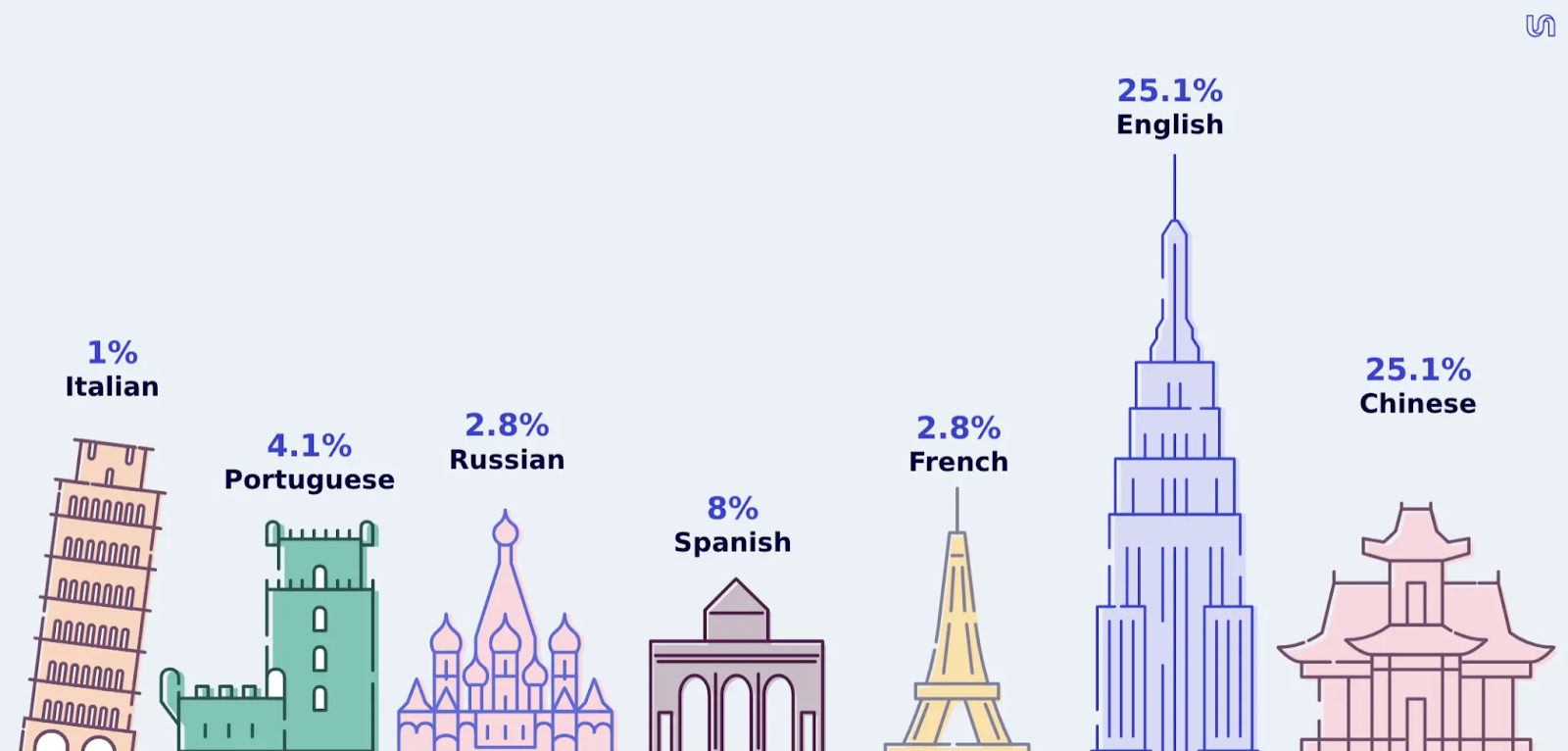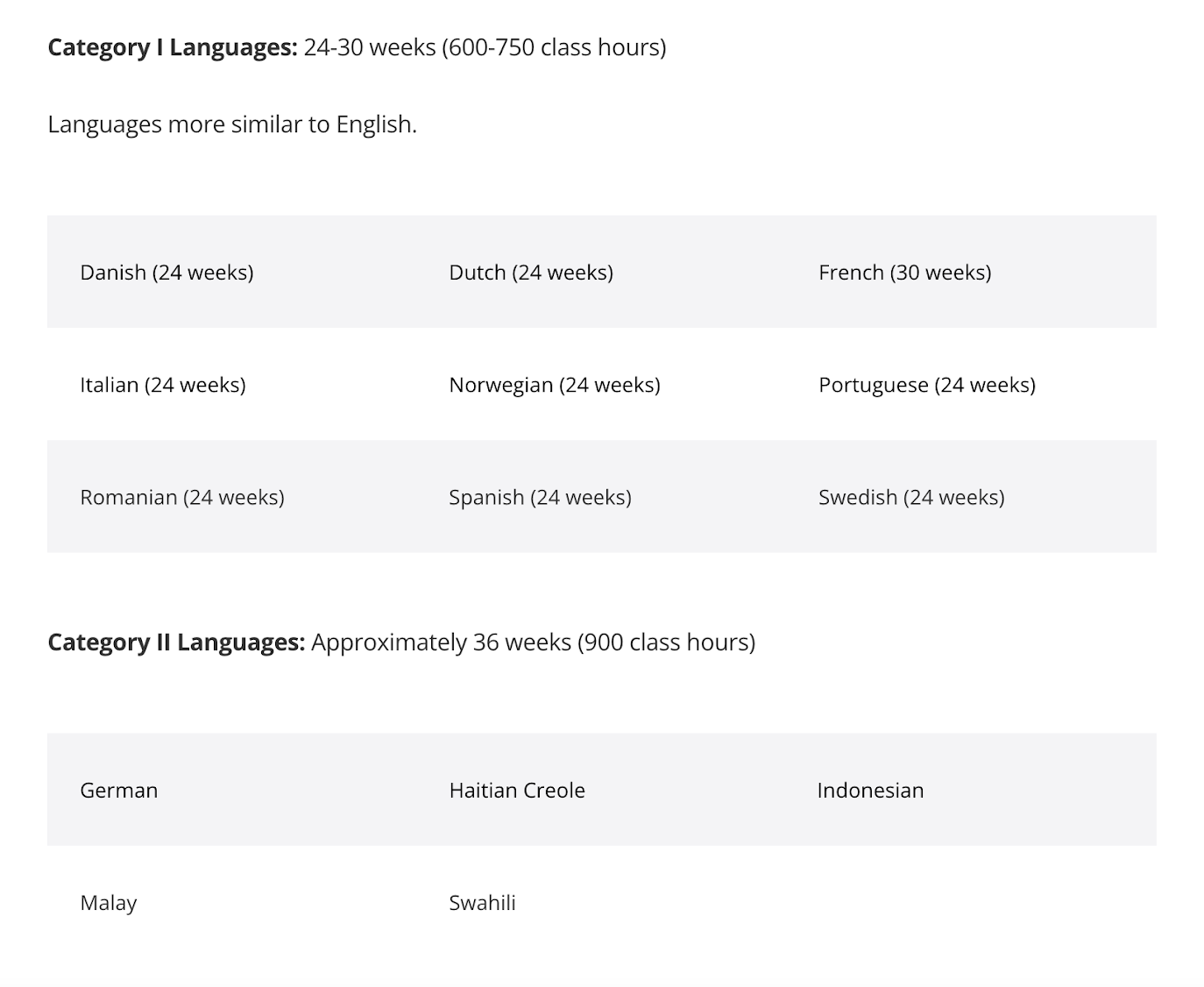The approach for language learning is quite similar to that for localizing a company’s customer experience: Don’t try to boil the ocean. What do we mean by that? Don’t aim for immediate fluency from the get-go — take it step by step and build solid foundations, as some lessons you’ve learned in one language may help you conquer another.
Much like localization, you’ll also want to approach language learning with an understanding of why you’re doing it. You might be learning a new language to help prepare for a new job, an international move, to connect with friends and family, or simply as a new hobby. Our clients at Unbabel localize their customer support, marketing campaigns, and other materials to meet the demands of their customers or to help them scale into new markets.
It’s a multilingual word, with only a quarter of online content in English. Understanding your drive can help you stay motivated when things get tough, or tongues get tangled.

What makes some languages easier to learn?
The similarity to your mother tongue: The more related a target language is to a speaker’s native language — roots, usages, and pronunciations — the easier it will be to learn. Hence, you’ll notice that many of the most difficult languages for English speakers to learn come from different language families, while the easiest all come from the Indo-European family that is shared with English.
Exposure: One of the reasons English is such a widely spoken language is due to the amount of exposure English learners have to it. English is dominant across so much media — from international news to TV and popular films and social media.
Ability to practice: Languages that are only spoken in their homeland can be harder to learn because you need to be in situ to practice. Languages that are more widely spread across the globe are easier to pick up because you’ll likely be able to find native speakers closer to home with whom to practice.
The US Foreign Service Institute has developed language learning timelines. Their scoring is based on the amount of time for native English speakers to reach “Professional Working Proficiency” in other languages. The timescale can, of course, be impacted by the language learner’s natural ability, prior linguistic experience, and time spent in the classroom.

Source: US Foreign Institute — View more
10 Easiest Languages for English Speakers to Learn
The following ten languages are most closely related to English, and are therefore the easiest for a native English speaker to learn:
1. Afrikaans
Like English, Afrikaans is in the West Germanic language family, once thought of as a Dutch dialect. Today, almost 9 million people globally speak Afrikaans, mainly in South Africa and Namibia.
It’s considered the easiest language for native English to learn, as it shares many Germanic-derived root words with English, which helps with pronunciation, and it has a logical and non-inflected structure, meaning most of its words don’t change based on gender, number, and tense.
Additionally, it only has three tenses: Past, present, and future, so learners don’t have to tackle cases like imperfect, pluperfect, and subjunctive.
Finally, Afrikaans doesn’t have verb conjugation. It’s a great language to learn for anyone wanting to dive deeper into South African media and entertainment, as it’s frequently used across these channels.
2. French
Ah, the language of love. French is a popular language to learn and ranks as the third most spoken language in Europe. Globally, it’s spoken by 300 million people, across France, Canada, Belgium, and Madagascar.
French speakers in France may use the same words as those in Quebec but words and phrases could have vastly different meanings or even no meaning at all. So it’s not a one-size-fits-all and text needs to be localized across these markets, generic machine tools aren’t always the right tool for the job.
As approximately one-third of the modern English language has been influenced by French, it’s considered familiar territory for a native English learner. English has more in common lexically with French than with any other Romance language, meaning an understanding of French vocabulary will come easier than others. This shared lexicon comes, in part, through the various wars and conquests between France and England, from which language was a symptomatic winner, or loser, depending on which side you were on. Words like à la carte, cliché, and déjà vu wormed their way into the English speakers’ vocabulary.
However, French learners should be vigilant for faux amis — false friends or false cognates — or words that look similar to English words but have different meanings: attendre (to wait for), journée (day), and préservatif (condom) are just a few.
3. Spanish
The prevalence of Spanish makes it a very popular language to learn: It’s the official language of 18 countries, across 500 million native speakers, makes up 8% of online content, and is used throughout several thousand TV shows.
Fortunately for learners, Spanish is a phonetic language, meaning words are pronounced as they are written. It also has fewer language irregularities (like the letter ñ) than other Romance languages.
Like other Romance languages, it derives from Latin — like many English words. So, there are many familiar cognates — words that are connected through the same linguistic derivation as each other. You should recognize correcto, delicioso, and ambulancia. (Slow brain day? They mean correct, delicious, and ambulance)
Despite the similarities, there are still some words that cannot be carried from Spanish to English, and require careful translation. For example:
4. Dutch
23 million people globally speak Dutch, though primarily in the Netherlands, Belgium, and Suriname. As mentioned above, it’s closely related to Afrikaans, and it’s possible for speakers to hold conversations in their native languages.
Another member of the West Germanic language family, Dutch mirrors English both structurally and syntactically. Due to shared vocabulary, Dutch sounds like a combination of German and English. Many words are spelled the same in Dutch and in English, even if they are pronounced differently. The two are similar with regards to vocabulary as well; groen is green, in English, and oude man is old man.
Furthermore, Dutch speakers often use English words, so much so the practice is called Dunglish. That said, there are still some words that don’t leap the language barrier, Uitwaaien��doesn’t have an equivalent in English. It means to relax in the countryside to clear one’s mind, a bit like the Danish term Hygge.

5. Norwegian
Norwegian or ‘Norsk’ is a language of the North Germanic family. Norwegian is losing its position as a key language for translation due to the fact that the language is only really spoken in Norway, plus the influx of Asian languages. But there’s still value in learning this relatively-easy language; for example, it’s handy if you want to dive deeper into Scandinavian literary culture and mythology.
Luckily for beginners, Norwegian has consistent pronunciation and easy-to-learn grammar. Verbs are straightforward, requiring no conjugation according to number or person. The rules of general conjugation are simple, requiring an ‘-e’ suffix for past tense and an ‘-s’ suffix for passive verbs. For the most part, the sentence structure is also quite comparable to English, which makes it an easy language for English native speakers.
6. Portuguese
Portuguese is the official language in nine countries, including Angola, Brazil, Cape Verde, Mozambique, and Portugal, which makes it a handy language to hone. Yet, while Portuguese speakers in Brazil may use the same words as those in Portugal, they may have vastly different meanings.
Many English speakers have discovered that Portuguese shares many direct similarities with English. For example, a question is introduced by intonation instead of rearranging verb forms like it is in English. ‘We’re arriving now,’ becomes a question by inflecting up at the end of the sentence: ‘We’re arriving now?’
Another treat for Portuguese learners: Like many European languages, Portuguese is better than English for expressing matters of the heart. Portuguese speakers use Saudade to express the longing for someone or something they once loved, now gone forever.

7. Swedish
Swedish or ‘Svenska’ is spoken by 10 million people in Sweden, but it is also used in neighboring countries of Finland and Denmark. Because it is a Germanic language, Swedish shares cognates like midnatt (midnight), gräs (grass), and konferens (conference) with English.
Like Norwegian, Swedish also has reasonably simple grammar rules and Swedish syntax follows the English subject-verb-object structure.
Retail giant IKEA has also given its homeland’s mother tongue an exposure boost: English speakers globally will have picked up some handy household terms while navigating the IKEA store maze. For example, Lack tables are named after the Swedish word for varnish.
See how IKEA used language to its benefit when scaling abroad.
8. Italian
If French is the language of love, Italian must be the language of food. English speakers — and cooks in particular — will already be familiar with a whole host of Italian words. Often found lurking in kitchen cupboards, spaghetti, passata, and (in the freezer) gelato have been adopted into the English language.
Additionally, as Italian has a vocabulary rooted in Latin, there are many English-Italian cognates like calendario (calendar), lotteria (lottery), and foresta (forest).
Over 60 million people speak Italian as their first language, found globally from Italy and the Vatican City to Costa Rica and Libya. There are differences across Italian-speaking locales, as physiotherapy association Physioswiss knew when it chose Unbabel to adapt its Italian content across its markets in Italy and Switzerland.
Italian is highly readable, sporting a simple alphabet consisting of only 21 letters (English has 26), so learners can quickly absorb the letters — perhaps while finishing a chilled gelato.
Learn how Italians’ love of food set them apart in marketing personalization for Ooni Pizza Ovens.
9. Romanian
Roughly 22-26 million people speak Romanian as their native language. It’s a unique language: Romanian is the only Romance language developed in the Eastern part of Latin Europe. Romanian learners have found that these Latin roots make it similar to English. It shares some common words, like contemporanii (contemporaries), and week-end bun (good weekend).
It also shares similarities with other Romance languages: La revedere (goodbye) is similar to the Italian Arrivederci, and Scuză-mă (an apologetic ‘Excuse me’) is related to the French Excusez-moi.
Luckily for learners, Romanian is a phonetic language, so most words are spelled the same way they are pronounced.
10. Hindi
Hindi is an official language of India, where at the last count more than 500 million people (over 50% of the population) spoke Hindi as either their first or second language. It’s also spoken in Mauritius, Fiji, Suriname, Guyana, Trinidad & Tobago, and Nepal.
A slightly more difficult language to learn than the top nine, Hindi will take the average English learner slightly longer to master. That being said, the English language has words of Hindi origin and has adopted many loanwords from Hindi — words adopted from a foreign language with little or no modification — such as jungle, guru, and karma.
Hindi also uses lots of English words, which are read and pronounced as they are in English, even if they look different in the Hindi writing system.

From similar vocabularies to parallel structures, all of the above languages relate to English in some way. Indonesian and Swahili are easy languages that didn’t place in the Unbabel list, but still equally worth exploring. However, if you’re after a challenge, Japanese, Korean, Arabic, Mandarin, Finnish, Hungarian, and Polish all make the list of the hardest languages to learn.
If this all feels like too much work, our Language Guides are a perfect stepping stone to getting into the culture of a new language — without the hours of work. Download your guide to the easiest language to learn.












